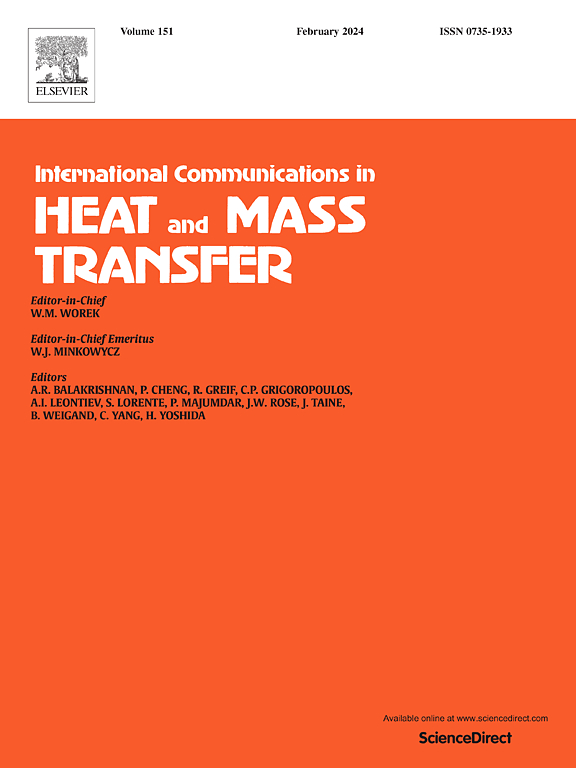π形腔内nepcm -水混合物双扩散混合对流及熵产分析
IF 6.4
2区 工程技术
Q1 MECHANICS
International Communications in Heat and Mass Transfer
Pub Date : 2025-07-22
DOI:10.1016/j.icheatmasstransfer.2025.109395
引用次数: 0
摘要
利用复杂几何形状的纳米封装相变材料(nepcm)的热系统为电磁控制下的高效能量存储和管理提供了有前途的解决方案。本文研究了在横向磁场作用下含有nepcm -水混合物的π形波盖腔内双扩散混合对流和熵的产生。数学模型在忽略粘性耗散和化学相互作用的情况下,对密度变化采用Boussinesq近似。在Reynolds(25-100)、Richardson(0.1-10)、Lewis(1-5)、Stefan(0.1-0.9)、熔合温度(0.1-0.9)、NEPCM浓度(0.01-0.04)和Hartmann数(0-80)的宽参数范围内,采用Galerkin方法对控制方程进行有限元分析。结果表明,雷诺数和理查德森数显著增强传热传质(Nusselt number增加204%),而磁场显著抑制对流输运(Nusselt number减少60.5%)。NEPCM浓度提高了39.3%的热性能,而对传质影响最小。熵产分析表明,热不可逆性占主导地位,磁场强度和NEPCM浓度都降低了系统的不可逆性。这些发现为优化从太阳能集热器到电子冷却解决方案等应用中的电磁调节热能储存系统提供了重要见解。本文章由计算机程序翻译,如有差异,请以英文原文为准。
Double diffusive mixed convection and entropy generation analysis of NEPCM-water mixture in a π-shaped cavity
Thermal systems utilizing nano-encapsulated phase change materials (NEPCMs) in complex geometries offer promising solutions for efficient energy storage and management under electromagnetic control. This study aims to investigate double-diffusive mixed convection and entropy generation in a π-shaped cavity with wavy lid containing NEPCM-water mixture subjected to a transverse magnetic field. The mathematical model employs the Boussinesq approximation for density variations while disregarding viscous dissipation and chemical interactions. Governing equations are solved using finite element analysis with Galerkin's method across wide parametric ranges of Reynolds (25–100), Richardson (0.1–10), Lewis (1–5), Stefan (0.1–0.9) numbers, fusion temperature (0.1–0.9), NEPCM concentration (0.01–0.04), and Hartmann number (0–80). Results demonstrate that Reynolds and Richardson numbers significantly enhance heat and mass transfer (up to 204 % increase in Nusselt number), while magnetic fields substantially suppress convective transport (60.5 % reduction in Nusselt number). NEPCM concentration improves thermal performance by 39.3 % with minimal effect on mass transfer. Entropy generation analysis reveals that thermal irreversibilities dominate, with both magnetic field strength and NEPCM concentration reducing system irreversibilities. These findings provide critical insights for optimizing thermal energy storage systems with electromagnetic regulation in applications ranging from solar collectors to electronic cooling solutions.
求助全文
通过发布文献求助,成功后即可免费获取论文全文。
去求助
来源期刊
CiteScore
11.00
自引率
10.00%
发文量
648
审稿时长
32 days
期刊介绍:
International Communications in Heat and Mass Transfer serves as a world forum for the rapid dissemination of new ideas, new measurement techniques, preliminary findings of ongoing investigations, discussions, and criticisms in the field of heat and mass transfer. Two types of manuscript will be considered for publication: communications (short reports of new work or discussions of work which has already been published) and summaries (abstracts of reports, theses or manuscripts which are too long for publication in full). Together with its companion publication, International Journal of Heat and Mass Transfer, with which it shares the same Board of Editors, this journal is read by research workers and engineers throughout the world.

 求助内容:
求助内容: 应助结果提醒方式:
应助结果提醒方式:


